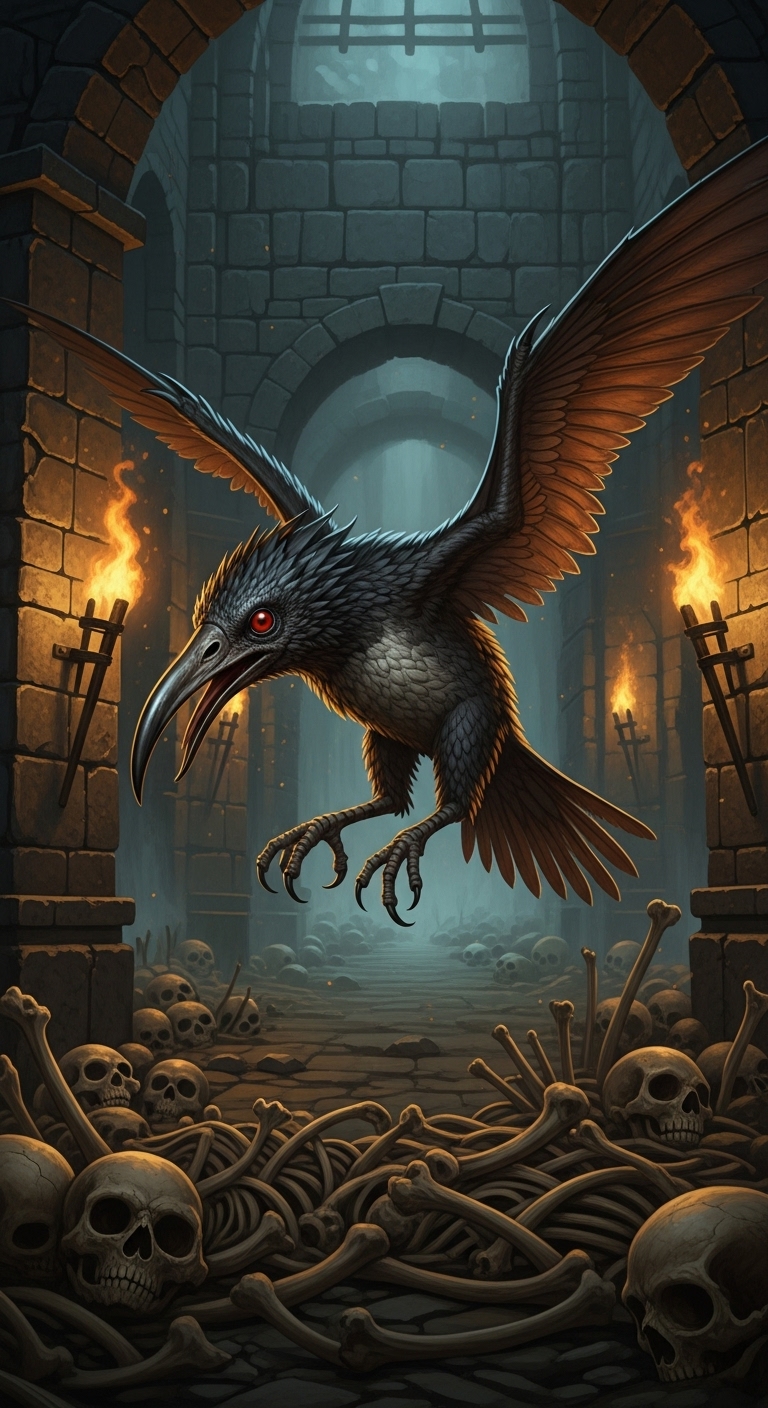Stirge

- Size: Tiny
- Type: Monstrosity
- Alignment: Unaligned
- AC: 13
- Initiative: +3 (13)
- HP: 5(2d4)
- Speed: 10 ft, Fly 40 ft.
| ATTR | VAL | MOD | SAVE |
|---|---|---|---|
| STR | 4 | -3 | -3 |
| DEX | 16 | +3 | +3 |
| CON | 11 | +0 | +0 |
| INT | 2 | -4 | -4 |
| WIS | 8 | -1 | -1 |
| CHA | 6 | -2 | -2 |
- Senses: Darkvision 60 ft.; Passive Perception 9
- Languages: None
- CR: 1/8 (XP 25; PB +2)
Actions
Proboscis. Melee Attack Roll: +5, reach 5 ft. Hit: 6 (1d6+3) Piercing damage, and the stirge attaches to the target. While attached, the stirge can't make Proboscis attacks, and the target takes 5 (2d4) Necrotic damage at the start of each of the stirge's turns.
The stirge can detach itself by spending 5 feet of its movement. The target or a creature within 5 feet of it can detach the stirge as an action.
Lore & Background
Stirges are grotesque flying creatures that resemble oversized mosquitoes with four gossamer wings and a long, needle-like proboscis designed for piercing flesh and draining blood. These creatures inhabit swamps, marshes, and other damp environments where they can find abundant prey and breeding grounds. Despite their relatively small size, stirges are dangerous predators that hunt in swarms, overwhelming larger creatures through coordinated attacks.
These blood-drinking parasites possess a primitive cunning that allows them to identify weakened or isolated prey, making them particularly dangerous to wounded adventurers or lone travelers. Stirges are drawn to warmth and the scent of blood, often following injured creatures for miles before striking when their target is most vulnerable. Their rapid reproduction rate means that stirge populations can explode if left unchecked.
Combat Tactics
Stirges attack by diving from above to pierce exposed skin with their proboscis, latching onto victims to drain blood while remaining difficult to dislodge. They prefer to attack in swarms, with multiple stirges targeting the same victim to maximize blood loss and minimize individual risk. Once attached, they become single-minded in their feeding, ignoring most threats until they have drained sufficient blood.
In combat, stirges use their flight advantage to stay out of reach while seeking opportunities to attach to enemies. They target lightly armored opponents and focus on areas where armor gaps provide access to flesh. Multiple stirges often coordinate their attacks to overwhelm a single target's defenses.
Encounter Ideas
1. The Swarm Ambush A large swarm of stirges attacks the party while they're crossing swampland or camping near water. The encounter tests the characters' ability to deal with multiple small threats while managing their positioning and resources.
2. The Breeding Ground The party discovers a stirge nest in a cave or marsh, revealing a massive infestation that threatens nearby settlements. They must decide whether to eliminate the threat directly or find ways to relocate the creatures without causing an ecological disaster.
3. The Blood Trail Stirges have been following wounded survivors of a recent battle, creating a dangerous situation for rescue operations. The party must protect the injured while dealing with increasingly aggressive stirge swarms drawn by the scent of blood.
4. The Domesticated Parasites A mad alchemist or druid has trained stirges to serve as guardians or harvesting tools, using their blood-draining abilities for experiments or rituals. The party encounters these unusually controlled stirges while investigating the practitioner's activities.
Environmental Effects
- Blood Scent Attraction: Any bleeding creature in stirge territory becomes a target for increased stirge activity
- Swarming Behavior: The presence of one stirge often signals others, leading to escalating encounters as more arrive
- Breeding Acceleration: Warm, damp conditions cause stirge populations to reproduce rapidly
- Disease Vector: Stirges can carry blood-borne diseases between their victims, potentially spreading illness
Treasure
- Stirge Proboscis (10-50 gp): Hollow needle-like organ useful for crafting piercing weapons or alchemical tools
- Blood Samples (varies): Different types of blood stored in stirge digestive systems, valuable for certain magical rituals
- Nest Materials (5-25 gp): Silk and organic materials used in stirge nests, suitable for crafting certain items
- Parasitic Ichor (25-100 gp): Concentrated stirge digestive fluids with properties useful in alchemy
- Wing Membrane (15-75 gp): Thin, durable material from stirge wings, suitable for creating waterproof items
Plot Hooks
1. The Plague Carriers Stirges in a region have become infected with a supernatural disease that they spread to their victims. The party must find the source of the infection while avoiding becoming carriers themselves.
2. The Noble's Curse A noble has been cursed to attract stirges wherever they go, making normal life impossible. The party must break the curse while protecting the victim from constant stirge attacks.
3. The Blood Farm Someone is deliberately breeding stirges to harvest blood for dark purposes, creating an ecological imbalance that threatens the entire region. The party must investigate the operation while dealing with unusually large and aggressive stirge populations.
4. The Symbiotic Relationship A community has learned to coexist with stirges, using them to control other pest populations in exchange for regular blood donations. When this balance is disrupted, the party must help restore the relationship or find alternative solutions.